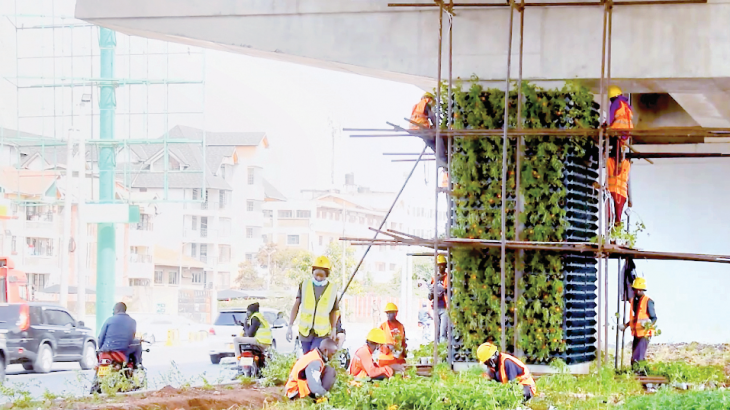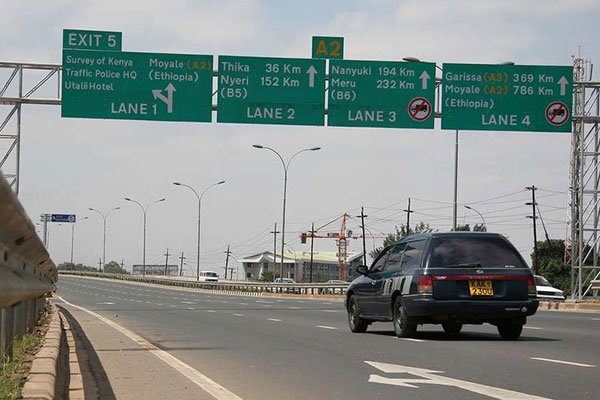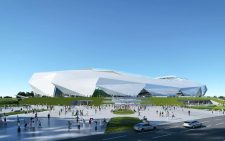Greening expressway to reverse environmental loss

If you happen to have used Mombasa Road lately, you will be greeted by an alluring sight of flowers and plants on pipe cubes fitted on the columns supporting the monumental Nairobi Expressway.
The flower planting is part of three greening exercises being carried out on the Expressway by Kenya National Highway Authority (Kenha) with an aim of preventing soil erosion, as well as fusing the character of engineering with the evironment, creating balance and beautifying the landscape of the highway. The other beautification activities will be grassing and tree planting
“We felt that the travel should not be boring. Covering of columns with plants gives it a soft architecture on the walls and brings relaxed feeling when travelling. It is also part and parcel of conserving the environment as the plants on the pillars will absorb carbon emitted from the vehicles using the expressway,” says the Kenha Deputy Director Engineer Julia Odenyo.
“They will be part and parcel of the environment that we find ourselves in. It is important to ensure trees are retained because of the contributions they make on climate change, “she added.
Odenyo further added that the conclusion to beautify the highway came as a result of fears by engineers that the expressway would have a negative impact to the environment.
So far, according to the National Environment Management Authority (Nema), 2,500 trees have been cut down to avail land for the project construction. Nema has given the Chinese company till the end of March to ensure that greenery is restored along the 27-kilometre stretch. In addition, it resulted in the loss of 13 different species of trees to make way for the four-lane dual carriageway that starts in Mlolongo and ends at the James Gichuru junction in Nairobi. “We estimated that they had removed 2,500 trees during the construction and we want them to plant at least 3,000 assorted tree seedlings to replace the tree cover lost during the construction process,” said Nema Director-General Mamo Boru Mamo.
Soil erosion
“Whereas road projects have a component for landscaping and environmental considerations, the ultimate environmental remedial works are more often than not limited to grassing. While grass has benefits, such as soil erosion control and improved aesthetics, its environmental benefits are limited and usually surpassed by its maintenance requirements,” explains Ruth Wanjiku, the Chairperson Landscape Architect’s Chapter -Architectural Association of Kenya (AAK).
Urban planner and researcher, Constant Cap feels that the bigger problem with the construction of highways in the country, has been the destruction of green spaces and the cutting of trees along transport corridors in the name of development. “A good example was Ngong Road where Satellite imagery shows that a number of the trees that were cut had no interference with the carriageway or road shoulder. We have seen similar actions along Mombasa Road and Uhuru Highway and parts of Waiyaki Way. It is easy to say ‘we will plant new ones, but it takes decades to grow some of these hardwood trees,” he observes.
He further adds that environmental sustainability needs to be part and parcel of development projects. “This stems from the built environment where residential buildings are coming out without any open space and engineering projects that are ignoring the needs of the most vulnerable groups (pedestrian crossings were after-thoughts along Thika and Outering roads). Greening of spaces needs to be developed from the concept stage and not as ‘something for later,” he notes.
Had landscape architects had been consulted at the design stage, Ruth notes that they would have developed planting plan that would provide guidance on plant selection in regards to their water and sun requirements. This would have resulted in a low maintenance landscape while providing ecosystem services. They would have also advised on the most appropriate methodology for the vertical gardens.
Ruth further adds that while the contractor of the expressway has taken measures to green the area under the footbridge using on ground planting and vertical gardens, the plant selection is not ideal. “Some of the plants selected are sun loving plants and will, therefore, struggle in the shade. Moreover, some of the plants are annuals and hence they will require replacement in the short term,” she says.
Since the construction of road infrastructure often leads to significant impacts on the environment that includes loss of vegetation, intrusion of views, fracturing of nodes and increased pollution, Ruth notes that it was necessary to have a landscape architect at both the design and construction stages so that the landscape planning is integral component of the road infrastructure. “The landscape architect guides on the plant species selection, plant composition, plant location, appropriate landscape furniture and the longterm maintenance strategy. Some of the key factors that should be considered in highway and road landscape design is the width of the planting area, sun intensity, shading, local climate, soils and water requirements. The plant species selected should be indigenous and adapted to the area, located according to sun requirements, have high potential for air purification, be hardy with a longlife span and require minimal watering after establishment,” explains Ruth.
Ecological benefits
Beautification is a term that is commonly used to refer to landscape improvements. Whereas the aesthetic component of the landscape has more often than not taken centre stage, focus should be on the environmental role of the landscape, such as providing ecosystem services. “Landscape architecture is a key component of green urban infrastructure system through design of urban areas, which are cooler and well drained, with reduced pollution, and room for nature to thrive. Introduction of vegetation in an urban setting reduces temperatures, increases water percolation and recharging of aquifers, aids in carbon sequestration and air purification and provides varied plant life enhancing biodiversity,” she says.
This approach to landscape planning shifts from beautification and aesthetics as the core objectives and seeks tap into the unseen ecological benefits of the landscape. For example, while many may view manicured lawn with a limited shrubs and trees at the periphery as beautiful, it is in ecological terms, a desert. Moreover, grass has high environmental and economic maintenance costs and thus its coverage should be limited as much as possible. The plant aggregation and location should be used to enhance storm water drainage whereas the species selection should be based on environmental benefits of the specific species.
Cities around the world are gradually moving away from expressways and other similar car dependent transport systems in place advocating for mass transit systems, such as BRT and rail. The spaces under expressway when not well planned often result in derelict spaces that host illegal activities or gradually become dumpsites.
Some of the best examples of utilisation of spaces under expressways include the Underpass Park in Toronto, which was a regeneration of a formerly derelict space under the expressway. The park transformed derelict and unused space beneath a series of overpasses into an inviting public amenity that reconnected the north and south parts of the neighbourhood.
“It is crucial that road infrastructure authorities, Kenha, Kenya Urban Rural Authority (KURA) and Kenya Rural Roads Authority (KeRRA) enhance their environmental departments to, include landscape architects in their teams. These professionals would then play a key role in the review of green infrastructure and oversee implementation of the same review and supervision of road projects,” she says in ending.










